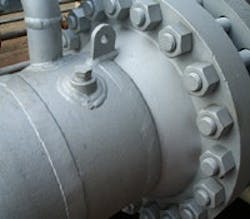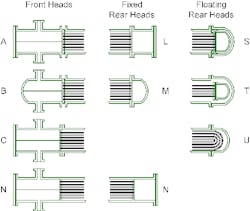Head Off Heat Exchanger Errors
Most process shell-and-tube heat exchangers are manufactured to Tubular Exchanger Manufacturers Association (TEMA) standards. These standards include a three-letter designation of the exchanger type that specifies overall mechanical layout in the form: front-end head, shell type and rear-end head.
TYPES OF HEADS
Figure 1. The Tubular Exchanger Manufacturers Association provides specific designations for heads.
Front-End-Head Guidelines
Table 1: Each type of head suits a different specific service.
N-type heads have the head, tube sheet and shell all welded together. They typically are selected when both the tube and shell sides contain hazardous materials. They also may be used in very clean shell-side services to save money. The design must allow for thermal expansion. Most exchangers will require expansion joints in the shell to accommodate thermal stresses due to different temperatures on each side. Without thermal expansion joints, the exchangers tend to leak at the tube sheet.The rear head can be either fixed or floating. The fixed-head types have similar configurations to front-end heads: the L-type resembles the A-type front-end head, the M-type the B-type front-end head, and the N-type the front-end N-type. They all have the same benefits and constraints as the corresponding front-end heads.Floating heads have completely different configurations. The floating head disconnects the rear end of the tubes from the shell. This allows for differential thermal expansion between the shell and tubes without need for expansion joints. Table 2 highlights particularly suitable uses for the most common rear-end-head types: the S, T and U. The S-type and T-type use an internal head; both allow for the simplest tube replacement.Floating-Rear-End-Head Guidelines
Table 2: The head variants best handle certain kinds of applications.
ANDREW SLOLEY is a Chemical Processing contributing editor. You can email him at [email protected].
Sponsored



